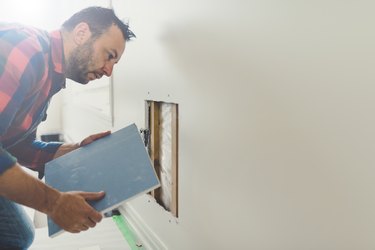
If you have a dead rodent in your walls, you will likely know it by the foul odor of death and decay. Unfortunately, the only way to know for sure where the rodent is located is to remove a piece of drywall to look behind the wall. With your sense of smell and a bit of detective work, you can narrow down the location but keep in mind this task is difficult even for professionals.
Find the Strongest Odor
Video of the Day
When you walk into a room, you will likely know you are in the right place. Depending on the construction of your home and the location of the room, there may be a lot of airflow that can move around the odor. This is why finding a dead rodent in an attic can be more challenging than in an area where the air is still.
Video of the Day
Once you are confident you are in the right room, sniff around the room near the base of the wall. The dead rodent is probably in the location where the smell is the strongest. Before removing the drywall, consider drilling a small hole and taking another sniff to confirm the location of the dead animal.
Since you cannot see behind walls, the smell is often the only clue to the location of the rodent. However, it is not always very precise. There are some other physical clues for which you can look, and understanding rodent behavior can also help you in your search.
Physical Signs and Clues
In many cases, when rodents die in the wall, it is because they were poisoned. Some rodents, like rats, make nests in the walls and will try to return to the nest when they are sick or dying. This is because the nest is a safe place and likely also warmer and insulated from drafts. Depending on the type of poison or illness, rodents may seek food or water prior to death. Keeping these behaviors in mind may help you pinpoint where the dead rodent is located once you narrow down the location by smell.
In addition, keep an eye out for discoloration on the wall. If the rodent is leaning against the wall when it dies, the decomposition process may stain the wall. Another option for finding the rodent is to use a thermal camera. While dead rodents no longer give off body heat, decomposition does generate some heat. However, the heat signature will be subtle, so if you aren't experienced in using this type of equipment, you are probably better off following your nose.
Remove a Dead Rodent
Once you locate the rodent, you need to remove it from behind the wall. Use a drywall saw to remove a piece of drywall large enough for you to see inside the wall and remove the rodent. Wear a pair of gloves to remove the rodent and secure it in a plastic bag. Dispose of the dead rodent in the garbage.
Then, thoroughly clean the area where the rat died. This will help remove the remaining odor that attracts flies and maggots and will help to kill pathogens that some rodents carry. Rats, for example, are known carriers of leptospirosis, Lassa fever and plague. Use a strong chemical or enzymatic cleaner to disinfect the area. Be sure to clean up any maggots and droppings that may be present.
Keep the room ventilated while you are cleaning to protect yourself from the fumes of the cleaner and any dust and pathogens that are stirred up while you clean. Dispose of the gloves when you are finished and wash your hands. Finally, patch the drywall to return the room to normal.